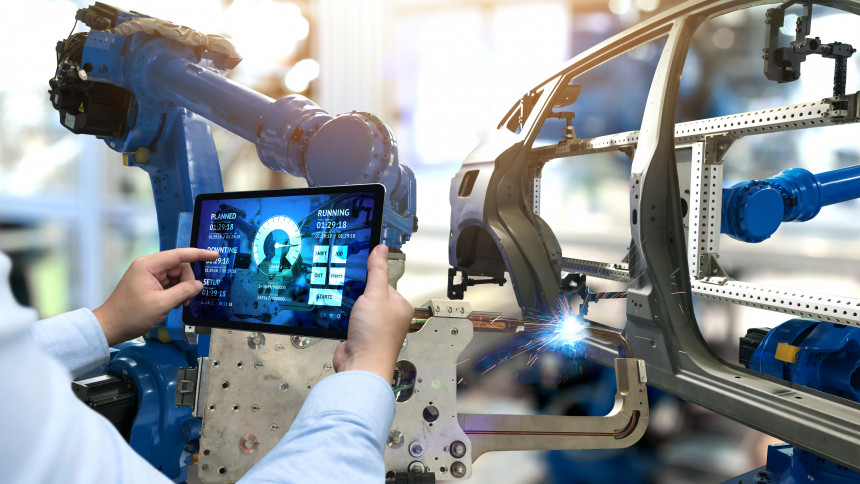Introduction: The Rise of Automotive AI
The automotive industry is undergoing a profound transformation, and at the heart of this change is artificial intelligence (AI). From autonomous vehicles to predictive maintenance and enhanced driver assistance systems (ADAS), AI is driving innovation across various facets of the automotive sector. As AI technology continues to advance, it is set to redefine not only how cars are built and operated but also how we experience transportation in the years to come.

Key Applications of AI in the Automotive Industry
1. Autonomous Driving
One of the most exciting applications of AI in the automotive industry is autonomous driving. AI systems enable vehicles to perceive and understand their environment, make real-time decisions, and drive safely without human intervention. This is achieved through a combination of machine learning (ML), computer vision, sensor fusion, and deep learning.
Autonomous vehicles (AVs) rely on LiDAR, radar, and cameras to detect objects, pedestrians, other vehicles, and road signs. These data points are processed by AI algorithms that help the car navigate safely in various traffic conditions.
For more insights into the role of AI in autonomous driving, visit Waymo’s Autonomous Vehicles.
2. Driver Assistance Systems (ADAS)
AI plays a crucial role in improving vehicle safety and driver comfort through Advanced Driver Assistance Systems (ADAS). These systems use AI to provide features such as:
- Adaptive Cruise Control – AI adjusts the vehicle’s speed to maintain a safe distance from other cars.
- Lane Keeping Assist – AI detects lane markings and helps keep the car within its lane.
- Automatic Emergency Braking (AEB) – AI can detect an imminent collision and apply brakes autonomously.
- Parking Assistance – AI systems can park the car in tight spots with minimal or no driver input.
These systems enhance safety and are a step towards fully autonomous driving. For more on ADAS, check out NHTSA’s ADAS Overview.

3. Predictive Maintenance
AI is transforming vehicle maintenance by enabling predictive analytics. Instead of waiting for a breakdown, AI-powered systems analyze data from sensors embedded in the car to predict when parts are likely to fail. These systems monitor components such as the engine, brakes, battery, and tires, allowing for proactive maintenance and reducing downtime.
Companies like Bosch are integrating AI into their systems for real-time monitoring and maintenance scheduling. This predictive approach not only improves vehicle lifespan but also minimizes repair costs.
4. Manufacturing and Supply Chain Optimization
AI is also optimizing the manufacturing process in the automotive industry. Robots powered by AI are used for tasks like assembly, welding, painting, and quality checks, leading to improved efficiency, precision, and safety on the production line. Machine learning algorithms are used to predict demand, manage inventory, and streamline supply chains.
For an example of AI in automotive manufacturing, see Toyota’s AI-driven Manufacturing.
5. AI for Personalization and In-Car Experience
AI is improving the in-car experience through advanced personalization. From voice assistants to AI-powered infotainment systems, cars are becoming smarter and more intuitive. For instance, AI systems can learn a driver’s preferences for seat position, climate control, and music, adapting to provide a more comfortable experience.
AI-based virtual assistants, such as Amazon Alexa, are now integrated into many vehicles, allowing drivers to control navigation, media, and vehicle settings via voice commands.

The Role of Machine Learning in Automotive AI
Machine learning, a subset of AI, is a key enabler of the automotive industry’s AI capabilities. ML models learn from vast amounts of data, improving over time to make more accurate predictions and decisions. This is particularly crucial for applications like autonomous driving, where real-time decision-making and continuous learning are essential.
For example, Tesla’s Full Self-Driving (FSD) system uses ML algorithms to improve its navigation, object detection, and path planning. The more data Tesla collects from its fleet of vehicles, the better its ML models become at handling different driving scenarios.
To learn more about how Machine Learning is used in autonomous driving, visit Tesla’s Full Self-Driving.
Challenges of AI in the Automotive Sector
While AI has immense potential in the automotive industry, several challenges remain:
1. Safety and Ethical Concerns
Ensuring the safety of AI-driven systems is paramount. Issues such as AI bias, data security, and decision-making in life-threatening situations must be addressed. For example, in an unavoidable accident, AI systems must be programmed to make ethical decisions, which is still a topic of ongoing research.
2. Data Privacy and Security
As AI systems in vehicles collect and process vast amounts of data, the risk of data breaches and privacy violations increases. Manufacturers must ensure robust data security and transparent privacy policies to protect drivers’ personal information.
3. Regulatory Hurdles
The widespread adoption of AI-driven vehicles is contingent on overcoming regulatory barriers. Governments worldwide are working to establish laws and standards for autonomous driving and ADAS systems to ensure they meet safety and ethical standards.
The Future of Automotive AI
The future of automotive AI is promising, with innovations on the horizon that could revolutionize the industry. Key developments to watch include:
- Level 5 Autonomous Vehicles: Cars that require no human intervention in all driving conditions.
- AI-Powered Smart Cities: Integration of vehicles with smart infrastructure to optimize traffic flow and reduce congestion.
- AI for Sustainable Mobility: AI can play a role in the development of electric and hybrid vehicles, improving energy efficiency and reducing carbon footprints.

Conclusion
The integration of artificial intelligence in the automotive industry is unlocking new possibilities, from autonomous driving to predictive maintenance and manufacturing optimization. As AI continues to evolve, it promises to redefine transportation, making it safer, more efficient, and more sustainable. However, addressing the challenges of safety, privacy, and regulation will be crucial for the widespread adoption of AI technologies in vehicles.
AI is not just the future of the automotive industry; it is the present. As AI continues to improve, we can expect even more innovative applications that will shape the next generation of vehicles.
Related Resources
NHTSA ADAS Overview or automotive developer — now is the time to pay attention.